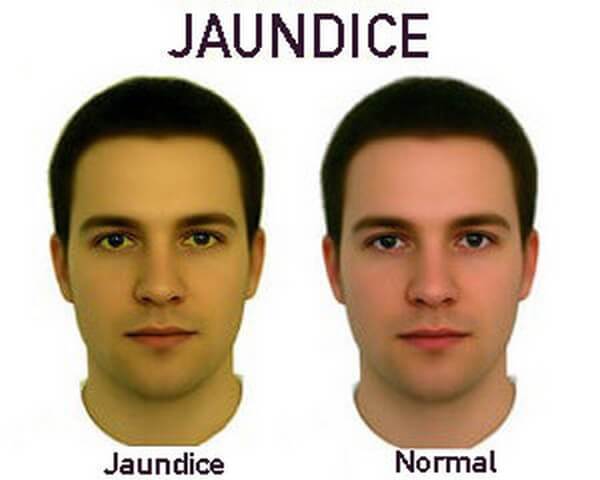Jaundice occurs with a visible yellowing of the skin and the white of the eye. It occurs with conditions associated with the blood cells, liver, and gallbladder. Jaundice can happen in people who who have stones in the gallbladder and those develop hepatitis [2]. It can also occur with Pancreatitis or Liver Cancer [1,4]. This presents with increased levels of Bilirubin that is a waste-product of recycling of red blood cells in your body. The levels of Bilirubin increase when there is more than normal breakdown of red blood cells. This Bilirubin should bind with the salts in bile juice. The bile juice is released in the intestine by the gallbladder to improve digestion of foods with fat-rich content. The Bilirubin is then excreted in the stool.
It occurs with conditions associated with the liver and gallbladder. Jaundice happens in people who develop hepatitis and those who have stones in the gallbladder. [2]
Symptoms of Jaundice
Skin Color: The body skin is discoloured with a yellow tinge to it. There is also yellowing of the sclera (the white of the eye). This can be easily seen in sunlight. It starts from the face and spreads to the trunk and legs. This yellow color acquires attention to some underlying disease. This condition is not harmful for the skin and recovery is complete when the disease is treated. [2]
Itching all over the Body: Due to any disease, that impedes the flow of bile juice into the intestine, there is the release of substances of bile in the blood. These substances cause itching all over the body. This can be alleviated by applying Vitamin E lotion. [3]
Dark coloured Urine: If Bilirubin cannot find its path to be excreted through the stools, it is removed from the body in the urine. [4]
Clay-colored Stools: The absence of Bilirubin from the stool gives it a clay-colored appearance. This is because of the undigested fats. [4]
There are other symptoms [5] that are originally associated with the underlying disease.
Abdominal Pain: Pain just beneath the rib cage on the right side of the abdomen can be due to stones in the gallbladder. Sometimes it is sensed only when pressure is applied.
Fever: Fever can occur when there is an excessive breakdown of red blood cells. Also, infection of gallbladder due to contamination of gallstones can cause fever. Fever is common in various liver diseases. Chills and rigor can accompany the condition.
Vomiting: You can feel nausea and vomit repetitively if there is swelling of the gallbladder due to stones. This can especially occur after food intake. Impaired function of the liver can result in built up of toxic substances in the blood that can also cause vomiting.
Fatigue: Increased loss of fluid and salts from the body takes place due to excessive vomiting. This makes you weak and exhausted.
Distension of Abdomen: Serious liver disease can lead to the collection of fluid in the abdominal membrane that causes distension.
Bleeding: Bleeding that does not stop easily can be the result of a deficiency of factors that clot the blood. These substances are produced by the healthy liver.
Dizziness and Palpitations: When jaundice occurs due to the breakdown of red blood cells, anemia results. Anemia can cause palpitations and lightheadedness.
Varices: Varices that are bleeding vessels of the gut can result in blood in the vomit. It can cause a serious hemorrhage.
Confusion and Drowsiness: When the liver disease has progressed to dangerous levels, toxic substances can reach the brain through the blood and have harmful effects like confusion, drowsiness, and agitation.
Weight Loss: Weight loss can occur if the cause of jaundice is the rare hepatocellular cancer of the liver. It is usually fatal if not cured by a liver transplant.
References:
[1] Frieden JH. The significance of jaundice in acute pancreatitis. Archives of Surgery. 1965;90(3):422-6.
[2] Owusu M, Bonney JK, Annan AA, et al. Aetiology of viral hepatitis among jaundiced patients presenting to a tertiary hospital in Ghana. PLoS One. 2018;13(9):e0203699.
[3] Bassari R, Koea JB. Jaundice associated pruritis: A review of pathophysiology and treatment. World Journal of Gastroenterology. 2015;21(5):1404–13.
[4] Subbiah V, West H. Jaundice (hyperbilirubinemia) in cancer. JAMA Oncology. 2016;2(8):1103.
[5] Kumar KPS, Bhowmik D. Jaundice-review of clinical features, differential diagnosis and remedies. The Pharma Research. 2010;4(2):241-52.




